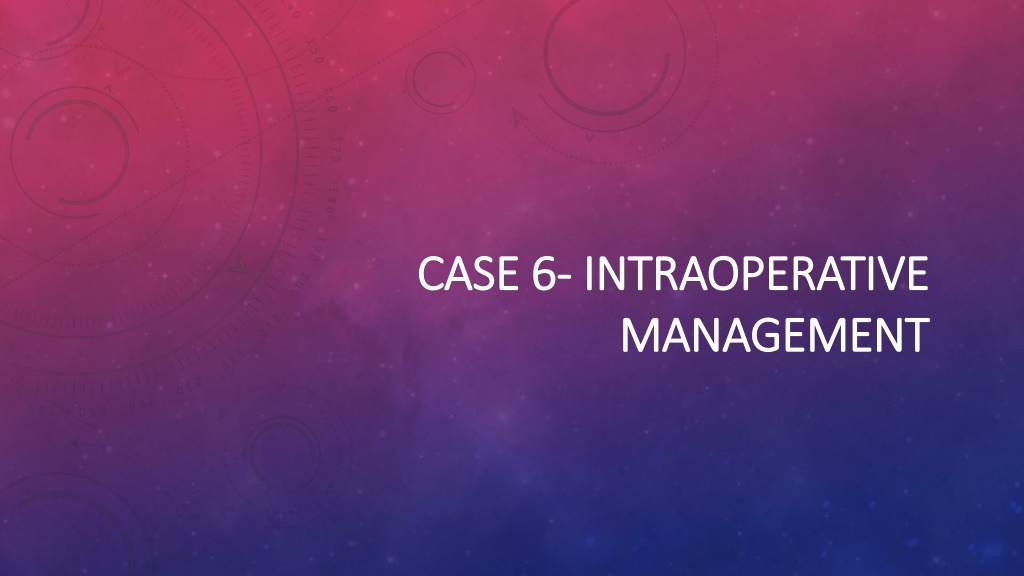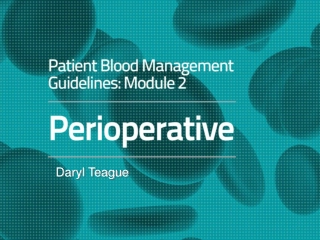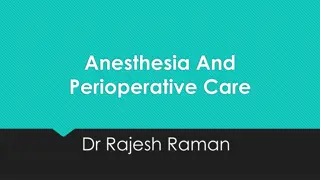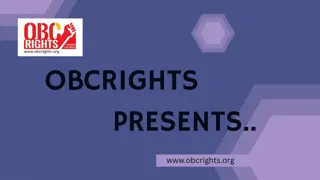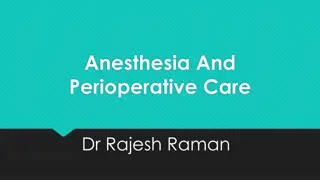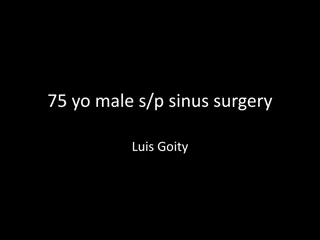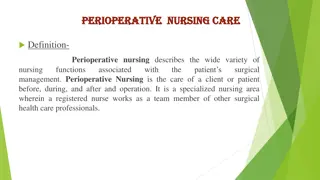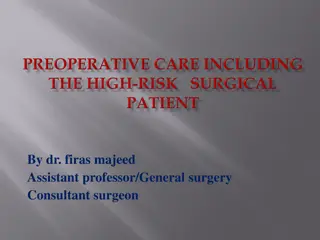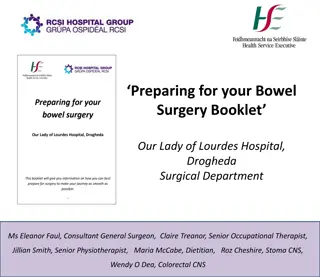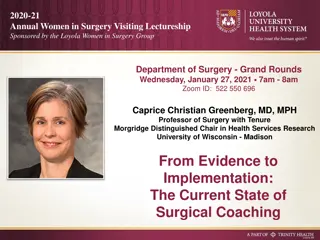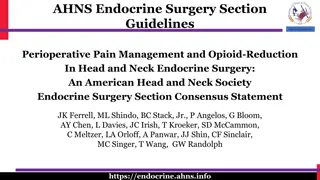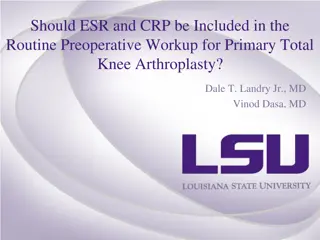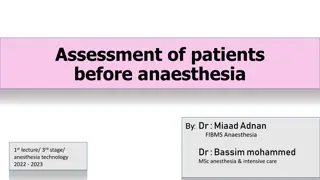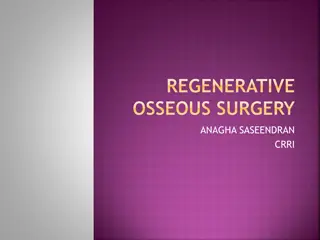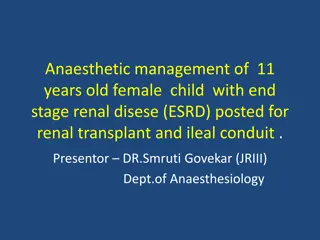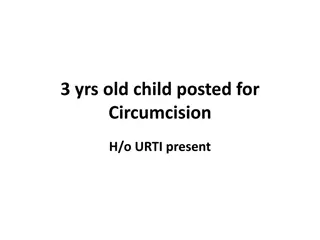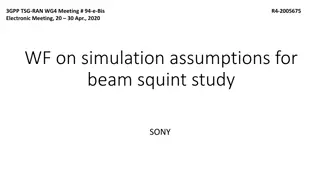Preoperative Assessment and Management for Squint Surgery in a 4-Year-Old Male Patient
Assessing a 4-year-old male patient booked for right eye squint surgery involves evaluating his preoperative risks, conducting necessary tests, assessing medication needs, and ensuring fasting protocols are followed. Key aspects include reviewing medical history, conducting physical examinations, addressing airway considerations, managing medications, and preparing the patient for surgery. Adequate preoperative assessment is crucial for safe and successful intraoperative management.
Download Presentation

Please find below an Image/Link to download the presentation.
The content on the website is provided AS IS for your information and personal use only. It may not be sold, licensed, or shared on other websites without obtaining consent from the author. Download presentation by click this link. If you encounter any issues during the download, it is possible that the publisher has removed the file from their server.
E N D
Presentation Transcript
CASE 6 CASE 6- - INTRAOPERATIVE INTRAOPERATIVE MANAGEMENT MANAGEMENT
A 4 A 4- - YEARS OLD MALE PATIENT BOOKED FOR YEARS OLD MALE PATIENT BOOKED FOR RIGHT EYE SQUINT SURGERY RIGHT EYE SQUINT SURGERY
1. HOW YOU WILL ASSESS THIS PATIENT PREOPERATIVELY. 1. HOW YOU WILL ASSESS THIS PATIENT PREOPERATIVELY. Timing of surgery *There are many classifications regarding type of surgery regarding the time ; immediate , emergency and elective. *In immediate cases there s no enough time to prepare your patient or at least improve his situation but these cases are rare, on the other hand emergency cases has few hours that you can spend them very well to prepare the patient. And for sure the elective surgeries there are plenty of time to make the patient as well as they can be. Assessment of risk Mainly depends on 2 things; patient condition and type of surgery.
1. HOW YOU WILL ASSESS THIS PATIENT PREOPERATIVELY. 1. HOW YOU WILL ASSESS THIS PATIENT PREOPERATIVELY. Preoperative assessment clinics Preoperative tests Perioperative medication *Mainly depend on Hx and PEx : *In Hx ask about: cardiac, respiratory, GI, renal , CNS , MSK , endocrine diseases. *Common tests include full blood count, electrolytes and urea, coagula- tion screen, ECG and chest X ray. In recent years, the emphasis has been on targeting tests to those at risk of abnormality *Generally, all medication is continued perioperatively except: drugs that affect coagulation (warfarin, heparin, aspirin, clopidogrel); * hypoglycaemics; Ask about medications, allergies and tobacco or alcohol intake. *Airway: start with airway history, documented difficulties with airway management, cervical spine problems (e.g. previous surgery or anky- losis), trauma or infection to the airway, previous scarring of the head and neck (e.g. radiotherapy or burns) and temporomandibular joint dysfunction all suggest potential problems with tracheal intubation. *For patients at risk and/or those undergoing major surgery (particu- larly vascular surgery) further, more detailed tests might include: liver function tests; arterial blood gas analysis; respiratory function tests; cardiac echocardiography cervical spine X ray may be required in those with suspected cervi- cal spine degeneration * some hypotensive drugs,e.g.ACE inhibitors ares topped only on the day of surgery. *Airway examination : On examination, poor mouth opening, obesity, a receding mandible and inability to protrude the mandible also suggest that tracheal intuba- tion may be difficult. *For insulin-dependent diabetic patients, long-acting insulin is generally discontinued and a sliding scale with short- acting i.v. insulin is commenced *However, urinalysis should be carried out for all patients. *Past anaesthetic history: ask specifically about anaesthetic problems. *Family history: ask specifically about malignant hyperthermia.
1. HOW YOU WILL ASSESS THIS PATIENT PREOPERATIVELY. 1. HOW YOU WILL ASSESS THIS PATIENT PREOPERATIVELY. Fasting Preoperative care No anaesthetic should be undertaken (unless it is an emergency) until the patient is fasted. This is to prevent both gastric acid and particulate matter entering the tracheobronchial tree, which can cause in the former case pneumonitis and in the latter case airway obstruction. Deep venous thrombosis (DVT) prophylaxis, methicillin resistant Sta- phylococcus aureus testing, together with all the preasessment paper- work, are collated.
2. DISCUSS FASTING TIME AND PREMEDICATION 2. DISCUSS FASTING TIME AND PREMEDICATION the patient seen in preoperative anesthesia clinic and cleared for squint surgery under general anesthesia, bwt: 16 kg Premedication Fasting: 1- Anxiolysis the best anxiolytic is the anesthetist who visits the patient and listens to the patient) Adults receiving general, regional, or monitored anesthesia care will be NPO after midnight preceding surgery. 2- Amnesia 3- Anti-emetic No anaesthetic should be undertaken (unless it is an emergency) until the patient is fasted. 4- Antacid 5- Anti-autonomic 6- Analgesic This is to prevent both gastric acid and particulate matter entering the tracheobronchial tree, which can cause in the former case pneumonitis and in the latter case airway obstruction. Therefore elective surgery should not proceed unless the patient has had >2 hours since clear fluid, >4 hours since milk and >6 hours since food. However, there are patients in whom the stomach can never guaranteed to be empty. These patients are at risk of aspiration of gastric contents and will require early tracheal intubation to protect the airway.
3. WHAT ARE THE PHYSIOLOGICAL DIFFERENCE BETWEEN ADULT AND 3. WHAT ARE THE PHYSIOLOGICAL DIFFERENCE BETWEEN ADULT AND PEDIATRIC PATIENT PEDIATRIC PATIENT Respiratory system: Oxygen consumption of neonates is more than 6 ml/kg which is about twice that of adults on a weight basis. To satisfy this high demand alveolar ventilation is doubled compared with that in adults. Because the tidal volume on a weight basis is similar for infants and adults, the increased alveolar ventilation is accomplished by an increased breathing rate Cardiac: Care must be directed to keep the infant warm, maintaining normal arterial oxygen and carbon dioxide tension and minimizing anesthetic induced myocardial depression
3. 3. WHAT ARE THE PHYSIOLOGICAL DIFFERENCE BETWEEN ADULT AND WHAT ARE THE PHYSIOLOGICAL DIFFERENCE BETWEEN ADULT AND PEDIATRIC PATIENT PEDIATRIC PATIENT Body water: The increased metabolic rate characteristic of neonates results in accelerated turn overs of ECF and dictates meticulous attention to intraoperative fluid replacement. Renal: the ability to handle free water and soluble loads may be impaired in neonates and the half-life of medications excreted by means of glomerular filtration will be prolonged Thermoregulation: The infant is especially vulnerable to hypothermia because of both the large ratio of body surface area to weight and a limited ability to cope with cold stress This problem is compounded by cold operating rooms, wound exposure, intra venous fluid administration, dry anesthetic gases and the direct effect of anesthetic agents on temperature regulation. Heat lost by conduction is reduced by placing the baby on a warm mattress and warming the operating room.
4. DISCUSS ANESTHESIA CONSIDERATION AND SPECIAL CONCERN FOR SUCH THIS SURGERY *This is usually undertaken on children under general anesthesia: -There are a number of issues:
5. DISCUSS ANESTHESIA PLAN , INDUCTION, MEDICATIONS METHODS FOR DISCUSS ANESTHESIA PLAN , INDUCTION, MEDICATIONS METHODS FOR SECURING THE AIRWAY , MAINTENANCE OF ANESTHESIA AND INTRAVENOUS FLUID REQUIREMENT. , MAINTENANCE OF ANESTHESIA AND INTRAVENOUS FLUID REQUIREMENT. SECURING THE AIRWAY During surgery the patient developed sever bradycardia maintenance of anesthesia induction Anesthesia plan Method for securing airway:Face mask : this is reliable airway for spontaneous ventilation and short episodes of intermittent IPPV Anesthesia can be induced intravenously or by inhalation. IV access may be challenging, as the veins may be small, poorly visible due to subcutaneous fat and painful even with topical anesthesia. Inhalation requires the ability to minimize entrainment of air and allow high concentration of anesthetic to reach alveoli. IV fluid requirement A plan of anesthesia should be discussed with parents includes the method of induction, postoperative analgesia and what to expect in term of i.v cannulae , infusions , nasogastric tube, etc. The medicationParacetamol: is NSAIDS: Diclofenac per rectum. Most would give 0.9% saline or hartmann solution. For resuscitation of children up to 20% ml\kg of colloid may be used as a bolus. Glucose containing solution are not usually used except in babies and those with hypoglycemia Maintenance of anesthesia in older children by spontaneously breathing techniques and short procedures. the most fundamental skill and should be familiar to all who deal with unconscious patient. A number of adjuncts can be used including chain lift , jaw thrust , guedel airway or nasal airway. often given in the word followed by regular postoperative doses. Laryngeal mask airway (LMA) : easy to insert , safe and Opioids: can be intravenously administrated as PCA or NCA. Local anesthesia: administrated into the wound or via nerve blocks. Tracheal tube: allowing full protection and IPPV
6. DISCUSS THE CAUSE AND TREATMENT DISCUSS THE CAUSE AND TREATMENT the surgery lasted 2 hours and the patient was extubated and shifted to recovery room the surgery lasted 2 hours and the patient was extubated and shifted to recovery room ------------- Differential Diagnosis for this case ----------- Management: -If Spo2<94% assume HYPOXIA until proven otherwise and must be treated immediately ! It is almost always the cause of intra operative bradycardia. -When hypoxia occurs, it is essential to decide whether the problem is with the patient or the equipment. Children undergoing such anesthesia are known to have a greater likelihood of developing intraoperative hypoxemia which Lead to hypoxia in part due to reduced functional residual capacity and higher metabolic requirements compared to adult. 1. Hypoxia 1-Administer 100% oxygen. 2-Ventilate by hand. 3-call for help and consider ABCDE . Note: Hypotension definitions in children aged 1-10 years: SBP < 70 +(age in years X 2) 4-Check for likely causes in a logical sequence and Treat causes as you identify them. 5-After a quick check of the common patient problems, make sure the equipment is working. It is a decrease in pulse rate ( marked bradycardia) associated with traction applied to extraocular muscles and/or compression of the eyeball. 2. The oculocardiac reflex Management: It can be avoided by pretreatment with an anti-muscarinic acetylcholine antagonist like atropine. This reflex is especially sensitive in neonates and children In such surgeries, However, it may also occur with adults.
6. DISCUSS THE CAUSE AND TREATMENT DISCUSS THE CAUSE AND TREATMENT Management of bradycardia in general Initial evaluation: -Assess appropriateness for clinical condition -Heart rate typically < 60 bpm if bradyarrhythmia Initial intervention: -Maintain patent airway -Assist breathing as needed -Administer oxygen if hypoxemic -Attach monitor/defibrillator -Monitor blood pressure and oximetry -Obtain intravenous (IV)/intraosseous (IO) access -Perform 12-lead electrocardiography (ECG); do not delay therapy -Check for signs of poor perfusion(Hypotension,Acutely altered mental status,Signs of shock) -Consider expert consultation Management of persistent bradycardia: -Administer epinephrine -Consider atropine for increased vagal tone or primary atrioventricular block (AV) block -Treat underlying causes
6. DISCUSS THE CAUSE AND TREATMENT DISCUSS THE CAUSE AND TREATMENT Squint surgery is usually undertaken on children under general anaesthetic. There are a number of issues: The airway is covered by drapes and needs to be secured either by a LMA, or in small children (<2 years old) a tracheal tube is often preferred. The oculocardiac reflex: pressure/tension on the globe or eye muscles can cause a marked bradycardia, which can be avoided by pretreatment with atropine. There is a high incidence of postoperative nausea and vomiting and pretreatment with an antiemetic is usually advisable. Suxamethonium is best avoided as this is a trigger for malignant hyperthermia (MH); there is a higher incidence of MH in patients undergoing squint surgery.
7. WHAT IS YOUR POST WHAT IS YOUR POST- -OPERATIVE ANALGESIA PLAN . OPERATIVE ANALGESIA PLAN . The surgery lasted 2 hrs and the patient was excubated and shifted to recovery room, What is your postoperative analgesia plan: Multimodal analgesia is used, which works on the principle that drugs acting by different mechanisms can result in additive or synergistic analgesia with lowered adverse effects. In particular there is an attempt to minimize opioids ( opioid sparing ) to reduce their adverse effects Most pain is self-limiting, with analgesic requirements falling by 48 hours, even after major surgery. For major surgery the use of infusion devices such as PCAs, epidurals or local anesthetic infusions around major nerves are used.
